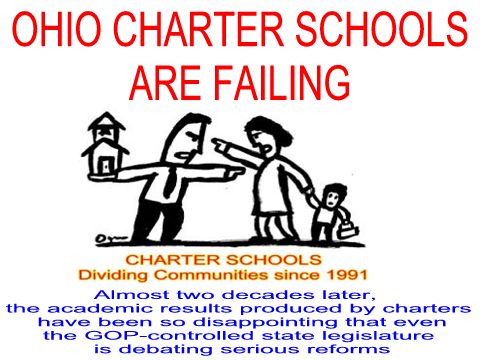Charter schools the problem, not other programs
Ohio’s problem with holding public charter schools accountable was well documented last week during a program at Elida High School that featured the executive director of the Ohio Coalition for Equity and Adequacy of School funding.
Charter schools have been a disaster.
Students who attend the state’s charter schools learn 36 days less math and 14 days less reading than traditional public school students, according to research done by the Hoover Institute at Stanford University. It crunched data obtained from student standardized test scores and ranked Ohio’s charter school performance 49th in the nation, with only Nevada being a worse gamble. That’s incomprehensible, considering that in 2013-14 when the study was done, charter schools accounted for more than 120,000 students, or 7 percent of the total public school enrollment in Ohio.
It doesn’t end there.
No sector in Ohio — not local governments, school districts, court systems, public universities or hospitals — misspends tax dollars like charter schools, according to research done a year ago by the Akron Beacon Journal. It reviewed 4,263 state audits and found charter schools misspent public money “nearly four times more often than any other type of taxpayer-funded agency.”
Clearly, the licensing of charter schools needs a major fix, to the point of closing down underperforming schools that falsely sell themselves as a good alternative to public education.
However, Ohioans should be careful not to confuse the failed charter school program with the state’s successful open enrollment and Educational Choice Scholarship Program (otherwise known as vouchers).
Thanks to these two programs, a ZIP code will not determine where parents send their child to school and what type of education he or she will receive. Parents are provided an option of where to send their children.
Yes, every time a student leaves their “ZIP code school,” that school loses its state funding for said student. That can be $4,650 each year for a student in kindergarten through eighth grade and $6,000 each year for a high school student.
That kind of money can add up quickly, and we won’t argue it can put a financial strain on a district.
However, there’s a reason the voucher program as well as open enrollment have seen significant growth the last 10 years. To put it frankly, they work.
Children who live in a ZIP code where a public school is underperforming have the opportunity to receive a better education through both programs. Time and time again we have seen how Ohio’s EdChoice program or its open enrollment program provide students with the tools they need to succeed.
Both programs can help break the cycle of poverty that plague a community by offering students the opportunity to get a high-quality education in a school that best fits their needs.
Isn’t that how we want our tax money spent?Editorial: Charter schools the problem, not other programs - LimaOhio.com - limaohio.com:


